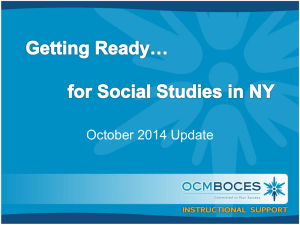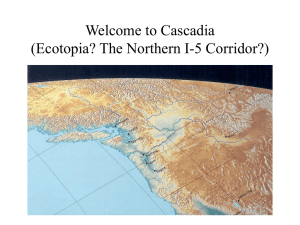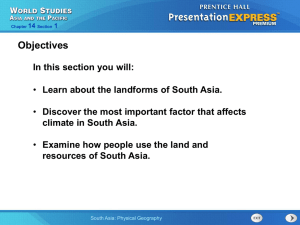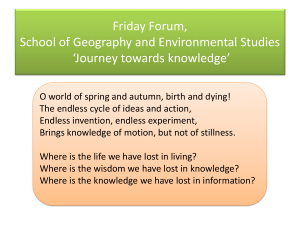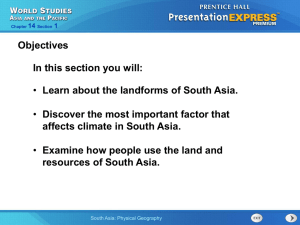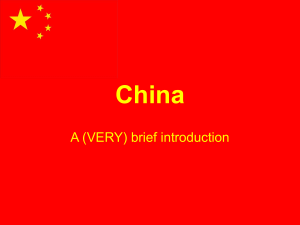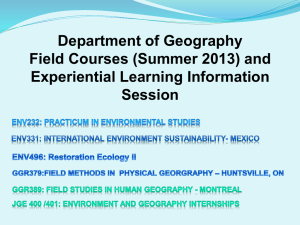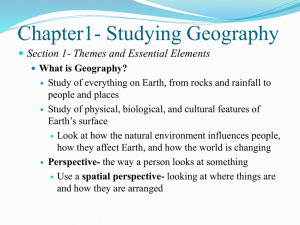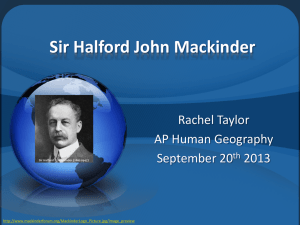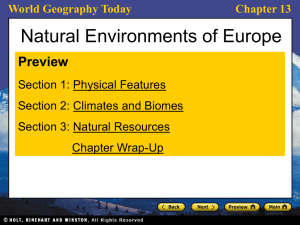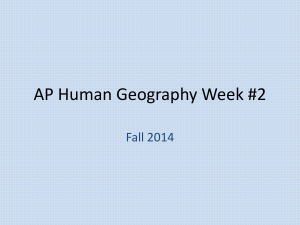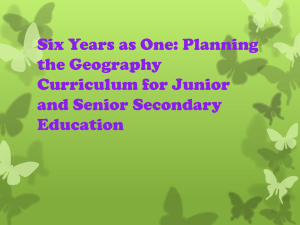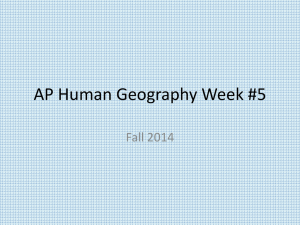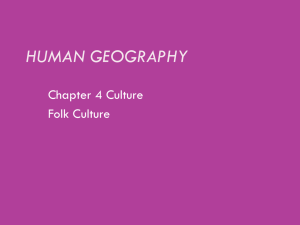UNCOVERING THE PAST
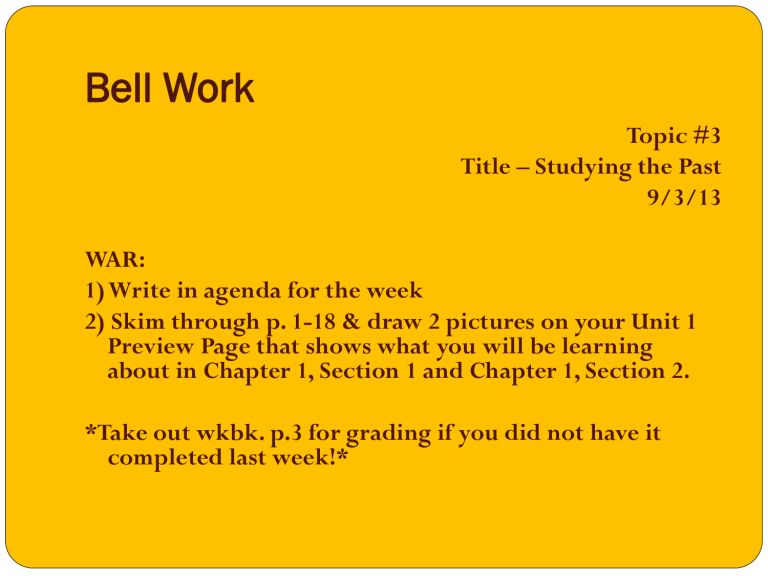
Bell Work
Topic #3
Title – Studying the Past
9/3/13
WAR:
1) Write in agenda for the week
2) Skim through p. 1-18 & draw 2 pictures on your Unit 1
Preview Page that shows what you will be learning about in Chapter 1, Section 1 and Chapter 1, Section 2.
*Take out wkbk. p.3 for grading if you did not have it completed last week!*
UNCOVERING THE PAST
CHAPTER 1
Section 1: What is History?
The study of the past
Historians: people who study history (well, duh!)
Want to know how people lived and why they did the things they did
Want to learn about their problems and solutions
Study the past to learn about people’s culture, which is the knowledge, customs, and values of a group
What is Archaeology?
Study of the past based on what people left behind
Archaeologists explore places where people once lived and examine objects to learn about the past
Bellwork
Topic #4
Title – Studying History Pt. 2
Date – 9/5/13
WAR: come in and get right to work! Copy question and answer in your ISN on the WAR side of your ISN
1 st , 6 th , 7 th period:
What are some benefits of studying history?
3 rd , 4 th , 5 th period:
What may tomorrow’s history books say about today’s world?
Knowing Yourself
http://www.youtube.com/watch?v=byDN8aoR4TI
Without your own personal history, you would not have an identity
Your past makes you who you are.
History teaches us about the experiences we have been through as a people.
It shapes our identity and teaches us the values that we share.
Knowing Others
History teaches us about cultures unlike our own.
It also helps us understand why other people think the way they do.
Consequently, we will learn to respect and understand our differences.
Promotes tolerance!
Knowing about the past can help build social harmony throughout the world
WAR
Topic#5 Understanding Through History
Date – 9/5/13
Answer ONE of the following questions:
1.
Name 2 groups of Americans who might interpret our history differently and why?
2.
3.
How does history help citizens around the world know their own countries better?
How do fossils and artifacts teach us about the past?
(Please write out the question you are answering)
Knowing Your World
History provides us with a better understanding of where you live.
It also helps us understand how the past shapes today’s events.
Worldwide events can affect anyone, anywhere.
History will help you gain a better understanding of science, math, religion, government, and other subjects.
You will develop mental skills and good decisionmaking skills, making us more productive adults.
“Those who forget their past are doomed to repeat it”
Using Clues
We rely on a variety of sources to learn history
We use fossils (animal or plant remains) for information on the first humans
Ex: bones and footprints
We also use artifacts (made by humans)
Ex: coins, arrowheads, tools, toys, pottery
Sources of Information
5,000 years ago writing was invented (yes, INVENTED!)
Writing gives us many clues about the past.
2 types of historical sources: primary and secondary sources
Primary source is an account of an event created by SOMEONE
WHO TOOK PART OR WITNESSED THE EVENT
Ex: treaties, letters, laws, diaries, court documents, or audio and visual recording
Secondary source is information gathered by SOMEONE WHO
DID NOT TAKE PART IN OR WITNESS THE EVENT
Ex: textbooks, journal articles, encyclopedias, biographies
Sources of Change
Writers of history don’t always agree.
People may interpret the past differently.
New evidence could lead to new conclusions.
Interpretations can and do change
END OF SECTION 1!
Bell Work
Homework: Make a map of fictional country and label at least 5 geographical items. How do the resources of your country support the people who live there?
TODAY’S TITLE: #6 Geography 9/9/13
TODAY’S GOALS: SWBAT use geography tools and know the difference between continents, countries, and cities.
WAR: Draw a map and write directions between 2 places in the classroom. Label important landmarks and use footsteps to estimate how long it will take to get from one place to another.
Homework: Wkbk. Pages 4-6
TODAY’S TITLE: #6 Geography 9/6/12
TODAY’S GOALS: SWBAT use geography tools and know the difference between continents, countries, and cities.
WAR: Draw a map and write directions between 2 places in the classroom. Label important landmarks and use footsteps to estimate how long it will take to get from one place to another.
SECTION 2: STUDYING PLACES AND
PEOPLE
Geography is the study of the earth’s physical and cultural features.
Physical Geography is the study of the earth’s land and features
- landforms: natural features of the land’s surface
(ex- mountains, valleys, plains, etc.)
- climate: pattern of weather conditions over a long period of time. Affects many features of a region such as plant life and landforms
Climate and landforms are part of the environment, which includes all living and nonliving things that affect life in an area.
HUMAN GEOGRAPHY
Human Geography: study of people and the places where they live.
Deals with how the environment affects people and how they live.
For example:
“Why do people live near rivers?”
“How do people living in the desert survive?”
May determine how people eat, dress, and what kinds of jobs people have.
Studying Location
Location tells where something is.
Every place on Earth has an absolute location AND relative locations.
No two places in the world are exactly alike.
Geographers try to understand the effects that different locations have on humans.
Studying Location
Absolute location – the exact latitude and longitude of a place
Relative location – the location of a place in relation to somewhere else
Learning From Maps
A map is a drawing of an area.
Maps can show many different kinds of things: physical features of geography, boundaries, symbols, rivers.
Most maps have a compass rose to show direction.
NO WIO TODAY
Bell Work
HOMEWORK: NONE
TODAY’S TITLE: #7 Geography Part 2
No new goal for today!
WAR: Answer the map questions 1-2 on page 14 . (They are located at the bottom of the page under the maps of Florida!)
1 st , 6 th , 7 th - **Have wkbk. Pages 4-6 out for grading**
3 rd , 4 th , 5 th - **Have map out for grading**
Learning About Regions
A region is an area with one or more features that make it different from surrounding areas.
Differences in features can be physical, dealing with climate, human populations, language, or religion.
Geography Affects Resources
Early on, people could only survive in areas where there was food and water.
Places had to be rich in resources, materials that people need and value.
Resources can include food, water, fertile land, stones, and metals.
Geography Shapes Cultures
Early people developed different cultures because of their environments.
Ex: Ancient Egyptians believed that the god Hapi controlled the
Nile River.
Geography also affects the growth of civilizations.
Most civilizations formed along rivers.
Geography can also provide protection from invaders.
Geography Influences History
Civilizations with many resources grew richer and more powerful than other civilizations that did not have as many resources.
Geography can also cause problems such as floods, drought, and storms
People can also affect the environment in positive and negative ways, which is a factor in history as well.
WIO
Complete #4 on p. 17 in your textbook
WIO: Where in the World?
You will be divided into groups and given a specific region to
“research”. List all the geographical features of your region with your group.
Then we will play “Where in the World?”. You will give clues to the other groups about your region, but DON’T SAY THE
NAME OF YOUR REGION! The group that guesses the region correctly gets a point. You will be able to flip through the atlases of your book in the back. The group with the most points at the end wins!





